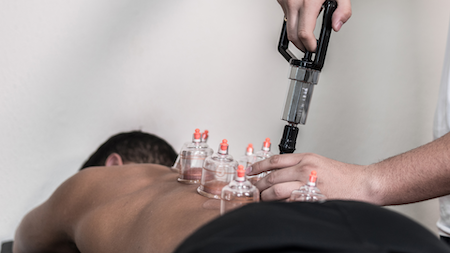Healing Through Cupping: The Basics

If you have ever visited a traditional Chinese medicine clinic, you’ve probably noticed glass jars filled with cups in the room. You may have also seen people with small circular redness and what looks like bruises on their skin from the cups. Cupping is a centuries-old form of natural healing that has recently gained popularity thanks to athletes, celebrities, and alternative medicine enthusiasts who swear by its benefits.
But what exactly does it entail? In this article, we’ll explore what cupping is, how it works, how it can help with various ailments—and whether or not this practice has any adverse side effects.
What Is Cupping?
Cupping is a form of alternative medicine in which a cup applies suction to the skin. It can help treat pain and other health problems by promoting blood flow, moving stagnant qi, and removing toxins from the body.
Cupping is often combined with other modalities, such as acupuncture or massage. It’s also thought to benefit people who have chronic pain conditions.
History of Cupping Practice
The history of cupping dates back over 2,000 years, when it was used in ancient China and Egypt. Its first appearance was in Eber’s papyrus (1550 BC). Its applications included pain, fever, and almost every other ailment. Over time, the practice traveled across continents and is now popular throughout Europe and America.
Initially, hollow horns were used to create the cupping suction on the body. Then, it evolved into bamboo and, finally, glass cups.
Cupping is still widely used for pain relief, but it may also be helpful with other conditions, such as muscle stiffness or stress.
How Does It Work?
Cupping practitioners believe that it increases the flow of blood and lymph, unblocks meridians, helps with pain relief, and speeds up recovery from ailments. They also believe cupping restores the body’s balance of “qi” or vital energy.
The practice involves using cups to create a vacuum on the skin and drawing up the underlying tissue. The cups remain in place for five to ten minutes before the practitioner removes them.
The therapist places the cups on your back, shoulders, arms, and legs in specific locations — often corresponding with meridians — while you’re lying down on your stomach. And you’ll likely experience relief and bruising as they’re pulled off your skin.
There are two main types of cupping: wet and dry. Both involve applying a vacuum to the skin, but wet cupping consists of making a small cut so blood can flow out as the cup sucks the skin out. Other types include running and flash cupping.
Cupping also has multiple subsets where it finds use, inducing;
- Sport cupping
- Orthopedic cupping
- Facial cupping
- Water cupping
Benefits of Cupping
The benefits of cupping therapy promotes healing in multiple ways, including the following:
- Improves blood circulation: Cupping causes blood vessels to dilate, which enhances blood circulation and helps eliminate toxins from your body as waste products.
- Relieves pain: Cupping therapy can help ease pain by opening up your blood vessels, bringing more oxygen and nutrients to your muscles and tissues, which helps reduce inflammation and soreness.
- Reduces stress: The negative pressure created during cupping causes micro-tears in muscle fibers, which stimulate the release of endorphins. These endorphins also have anti-inflammatory effects that decrease pain perception and promote relaxation by slowing down the heart and respiration rates.
Also, cupping helps alleviate sinus congestion, headaches, and even post-workout muscle soreness. It helps with a variety of health issues, including:
- Arthritis
- Body pain
- Asthma
- Hypertension
- Diabetes
- Cellulite
Negative Effects of Cupping
Cupping is generally safe when practiced by a qualified practitioner. However, some side effects can occur. They include:
- Bruising or bleeding at the cupping sites
- Infection
- Swelling or pain at the site of cupping.
- Dizziness
- Nausea
Final Thoughts
Cupping is a worthwhile healing therapy for many people. So, what’s the truth about cupping therapy? Is it worth trying? Only you can decide for yourself, but this article has presented you with all the information needed to make an informed decision. Overall, the medical benefits of cupping speak for themselves. It looks like this ancient therapy isn’t going anywhere anytime soon.


Leave a Reply
You must be logged in to post a comment.